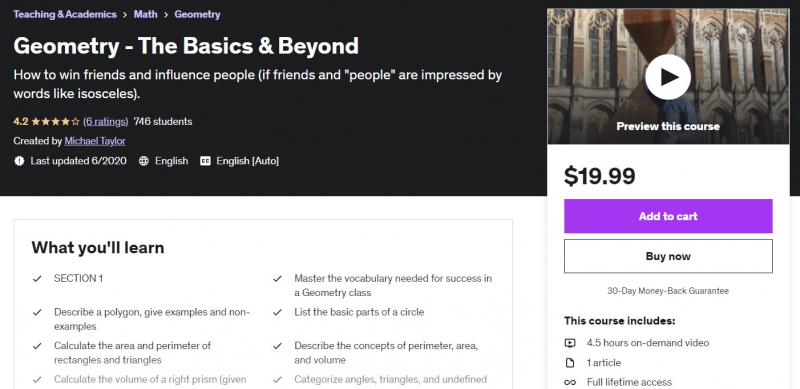Geometry - The Basics & Beyond

Because there was such a huge demand for their basic course, they decided to expand it and charge a little price for the extra time and work involved in putting these lectures and other resources together. The first expansion covers roughly a fourth of the Common Core criteria and includes explanation and practice. It incorporates all of the "Congruence" standards, which include the new focus on transformations as well as many classic two-column proofs. They intend to eventually complete all of the Common Core standards, either here or in other classes. Having taught geometry for almost a decade, they've learned that one of the biggest challenges is simply the vocabulary. This first (and original) section is a very broad overview of geometry and the language that it uses. If you've never heard of this vocabulary, this will introduce it. If you have, this will reinforce it and put it into context.
Some of the words and concepts addressed are commonplace, although others are specialized and not commonly seen in regular discourse. Some of these terms should be familiar to you, while others may not. The course also offers a lot of practice tools from various sites, as well as Udemy-style quizzes. There's an old joke about how much you remember from a college course five years later. It is supply and demand in economics. The periodic table is the arrangement of the elements in chemistry. Always begin with an outline while writing an English composition. This brief course follows in the same vein: it will offer you a rough sense of geometry concepts without going into too much depth. If you don't perform any of the activities, you might watch the first portion in one sitting. A better approach would be to set aside one day per week to view one video (less than 10 minutes) and then spend 20 minutes after each lecture exploring the additional content.
To begin, a bit about Common Core. If you live in a state with rough math standards, Common Core is merely a nationalized version of a variation of what has been taught over the previous 20 years. It emphasizes certain new issues while ignoring others, but it is essentially a road map for a giant topic. There is only so much that can be learnt on any particular topic in 180 school days; these standards seek to highlight what is relevant and what is not, both in general and in relation to what will be on state/national assessment assessments. There are 13 standards related to “congruence” in the New Common Core and this section explains (at varying levels of depth in its first iteration) all of them. They attacked this first because it had transformations in it and it was the one topic they knew they would have to do a fair amount of research on before they could teach it.
Who is this course for?
- This course is meant for those wanting to explore introductory concepts at a high level. This would include a student who is about to take a geometry class, is feeling behind in their geometry class, or wants review before an end of semester exam. This class covers most of the vocabulary and concepts related to shapes, area, perimeter, volume, and angles.
- Students looking for a more in-depth course should not take this course. This basic review does NOT cover proof, trig, the Pythagorean theorem, transformations, or extensive calculations.
Requirements:
- This course only assumes basic English fluency and basic numerical fluency.
- A notebook for taking notes is always a good idea.
- Many of the supplemental exercises are on the internet and will require internet access, but no particular browser or software is required.
- A positive mental attitude (and a full house) beats a bad attitude (and a full house) any day of the week.
Udemy rating: 4.2/5
Enroll here: https://www.udemy.com/course/geometry-the-basics/









